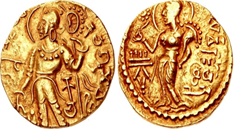

Context
Recently, the coins used in the Kushana Empire have been found with images consisting of God and Goddesses and are considered the first to use the image of ‘Goddess Lakshmi’ on their coins.
- India has a long tradition of coinage with images of gods and goddesses.
- The Coinage of India began anywhere between the early 1st millennium BCE to the 6th century BCEand consisted mainly of copper and silver coins in its initial stage.
- The coins of this period were ‘Karshapanas’ or ‘Pana’.
- The kingdoms that minted their own coins were; Gandhara, Kuntala, Kuru, Magadha, Panchala, Shakya, Surasena, Saurashtra, and Vidarbha, etc.
- The Vijayanagara kingsalso used coinage with Hindu idols.
- Harihara –II (1377-1404) introduced coins that had Brahma-Saraswati, Vishnu-Lakshmi, and Shiva-Parvati.
- The tradition of minting coins to win the confidence of local people continued when the French and Dutch minted coins showing Vishnu between 1715 and 1774 and Goddess Kalitill the late 17th century.
Do you know?The tradition of ‘Indian coinage’ in the 2nd millennium evolved with Indo-Islamic rule in India and the British Raj in the 19th century. |
Background
The Coins discovered:
- According to historians, the Kushans, who hailed from the Central Asian region and ruled till the 3rd century AD, were the first to use the image of Goddess Lakshmi on their coins, along with ‘Ardochsho’, the Iranic Goddess of wealth.
- The Kushans also depicted Oesho (Shiva),moon deity Miro and Buddha in their coinage.

- Evidence found: A specimen is now in the British Museum repository which mentions that coins were fundamental to their acceptance and success as currency, and Mohammed bin Sam issued these coins which maintained a visual tradition begun in India.
The Kushana Empire:
- Kushanas were descended from the Yuezhi, a people that ruled over most of the northern Indian subcontinent, Afghanistan, and parts of Central Asia during the first three centuries of the Common Era.
- The Yuezhi conquered Bactria in the 2nd century BCE and divided the country into five chiefdoms, one of which was that of the Kushans (Guishuang).
- Under Kaniska I (flourished 1st century CE) and his successors, the Kushan kingdom reached its height.
- It was acknowledged as one of the four great Eurasian powers of its time (the others being China, Rome, and Parthia).
- The Kushans were instrumental in spreading Buddhism in Central Asia and China and in developing Mahayana Buddhism and the Gandhara and Mathura schools of art.



